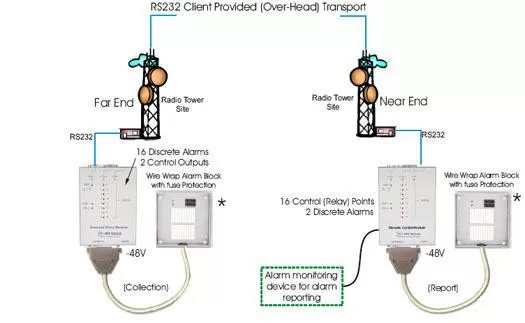Download our free Monitoring Fundamentals Tutorial.
An introduction to Monitoring Fundamentals strictly from the perspective of telecom network alarm management.
1-800-693-0351
Have a specific question? Ask our team of expert engineers and get a specific answer!
Sign up for the next DPS Factory Training!

Whether you're new to our equipment or you've used it for years, DPS factory training is the best way to get more from your monitoring.
Reserve Your Seat Today
Equipment Used:
For this solution, you will require one DB37 Wire Wrap Block for each Discrete Point Module and Discrete Control Module.
This solution will fulfill your need to detect contact closures at your remote site and replicate those at your central site over a dedicated RS232 connection (not dialup). When the DPM detects a discrete alarm, it will then send that alarm via RS232 to the DCM. You can use a discrete monitoring device (such as the NetGuardian) to monitor the contacts of the DCM for alarm reporting.
The optional wire wrap termination blocks allow for easier alarm termination to the DPM and DCM.
The DPM has a capacity of 16 discrete inputs, and 2 control outputs. The 16 discrete inputs allow you to monitor 16 different environmental conditions. You can monitor such things as commercial power, door entry violation, room temperature etc. Anytime a fault alarm is detected; the DPM's built in RS232 will communicate over your provided RS232 channel to the DCM and trigger a specific contact relay (discrete).
The DCM is the opposite in that it has 16 control outputs and 2 alarm inputs. Both the DPM & DCM are software programmable.
In this application, the DPMs & DCMs have been equipped with a dedicated RS232 interface. The units are in continuous communications with each other, so they can transport the alarm conditions within a few seconds. An error indication is also provided should the communication link fail.
In echo mode the DPM will communicate over a RS232 line to your Discrete Control Module (DCM). The DCM relays operate when the DPM detects an alarm, providing 16 contact-closures that follow the alarm inputs point-for-point. Likewise, the DCMs two alarm inputs operate the two respective relays at the DPM. This is especially useful in converting alarms between systems with unlike protocols or for transporting alarms from small remote sites to large, centrally located remotes or enunciator panels.
Both DPM models can be used in the echo mode application and they will be powered a -48V supply.